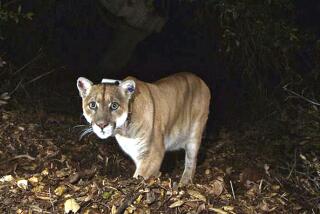Wildlife. The Fight for Space. : As homes march up hillsides and offices sprout on fields, Orange County’s wildlife battles for its dwindlng habitat. : Audubon, Irvine Co. Protect the Herons
- Share via
Peter Bloom used to watch the great blue herons on Irvine Lake when he played there as a child.
Today, Bloom is vice president of the Sea and Sage chapter of the Audubon Society and he is working with the Irvine Co. on a plan to build new homes in his childhood playground without disturbing the county’s largest colony of the giant, graceful birds.
Bloom and Ginny Chester, also of the Audubon Society, helped negotiate the East Orange General Plan, which was approved by the Orange City Council in December, so that the Irvine Co.’s development plans would not endanger the heron.
At Bloom’s suggestion, the company agreed to relocate two housing tracts and preserve 200 acres of wild oak groves near the proposed Limestone Canyon Regional Park. It also agreed to a five-year study and relocation plan for a colony of great blue herons that nest on the north shore of the lake where the company wants to build a road.
About 30 pairs of herons nest in sycamore and oak trees along the shore of the Irvine Lake, also known as Santiago Reservoir. The Irvine Co. has agreed to either get the birds to move to new nests or abandon its plans to build a road there, said Lee Jones, resource specialist for Michael Brandman Associates, which prepared the environmental impact report for the development.
In the study, biologists will determine where the herons eat, how many are breeding successfully and where they go in the winter. They will also coordinate the study with the federal Fish and Wildlife Service and the state Department of Fish and Game, Jones said. Leg bands will be placed on the young birds to keep track of them, he said.
After studying the birds, the biologists hope to encourage the herons to nest somewhere else, either along the southwest edge of the lake, on an island in the lake or elsewhere in Orange County.
In Orange County, herons are found along the Santa Ana River, Bolsa Chica Reserve, Upper Newport Bay, San Joaquin Marsh, Anaheim Lake and Dana Point Harbor. Bloom said the Irvine Lake rookery is the largest in the county.
Jones said the relocation program might include the planting of vegetation at other sites and the use of nesting platforms or heron decoys to encourage the birds to breed elsewhere.
After monitoring the new nesting site for three years and conducting annual counts of the breeding colonies, biologists will decide whether they can develop in the area without damaging the heron colony.
Under an agreement between the Audubon Society and the Irvine Co., the road could be built if at least 50% of the birds from the Irvine Lake rookery are nesting elsewhere. If not, the company could continue the relocation program or abandon its plans to build the road.
“If the Irvine Co. does this right, meaning funding the study properly, this could be a one-of-a-kind study,” Bloom said. Not much is known about the habits of great blue herons, he said.
Adult great blue herons stand three to four feet high, with a wing span of about six feet. Sometimes mistaken for cranes, herons can be distinguished from other birds by the U-shape of their neck in flight.
Although they were hunted for their colorful blue-gray plumage earlier in the century, great blue herons are not now listed as endangered or threatened. But biologists say that development has reduced the habitat of herons, putting them at risk.
More to Read
Sign up for Essential California
The most important California stories and recommendations in your inbox every morning.
You may occasionally receive promotional content from the Los Angeles Times.













